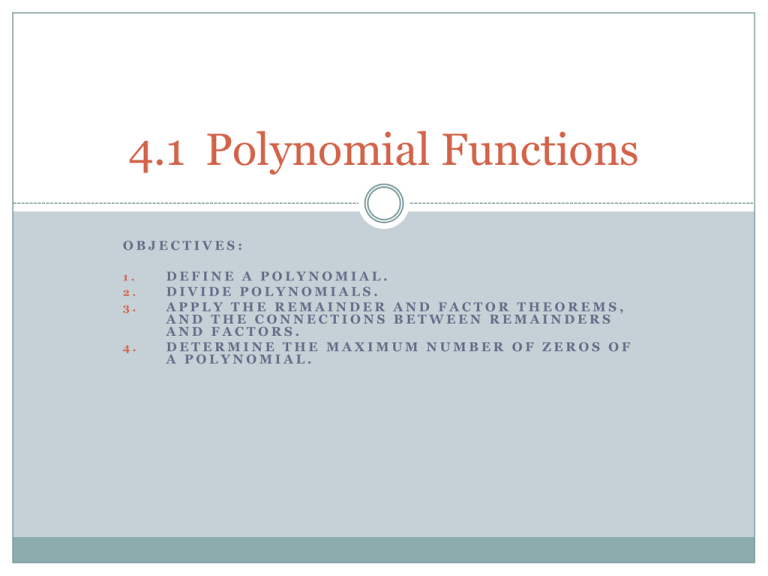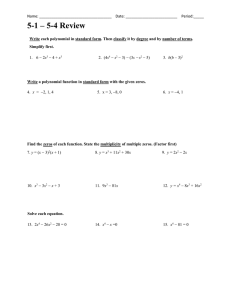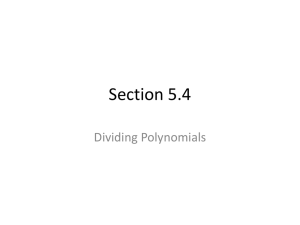4.1 Polynomial Functions
advertisement

4.1 Polynomial Functions OBJECTIVES: 1. 2. 3. 4. DEFINE A POLYNOMIAL. DIVIDE POLYNOMIALS. APPLY THE REMAINDER AND FACTOR THEOREMS, AND THE CONNECTIONS BETWEEN REMAINDERS AND FACTORS. DETERMINE THE MAXIMUM NUMBER OF ZEROS OF A POLYNOMIAL. Polynomials Characteristics of Polynomials: A sum or difference of monomials All exponents are whole numbers No variable contained in the denominator No variable is under a radical Polynomials 1 2 x 2 5 7 2y 7y 1 x 3 6x 2 y 15 y 10 w 6.7 12 Not Polynomials 1 3 m 2 m 5 p2 3 p Degree of a Polynomial Example #1 Polynomial Division Divide: 2x 25x 30x 5 by x 4 4 2 Expand the dividend and fill in missing terms, then follow the same steps as when dividing real numbers: divide, multiply, subtract, bring down. 2x3 x 4 2 x 4 0 x 3 25 x 2 30 x 5 (2x4 − 8x3) Bring down Subtract 8x3 – 25x2 Divide 2x4 2x3 x Multiply 2 x3 x 4 2 x 4 8 x3 Once this cycle is made once, it is repeated until the degree of the remainder is less than the degree of the dividend. Example #1 Polynomial Division Divide: 2x 25x 30x 5 by x 4 4 2 2x3 + 8x2 x 4 2 x 4 0 x 3 25 x 2 30 x 5 (2x4 − 8x3) – (8x3 – 32x2) 8x3 Subtract 25x2 7x2 Bring down – 30x Divide 8 x3 8x2 x Multiply 8 x 2 x 4 8 x3 32 x 2 Example #1 Polynomial Division Divide: 2x 25x 30x 5 by x 4 4 2 2x3 + 8x2 + 7x x 4 2 x 4 0 x 3 25 x 2 30 x 5 (2x4 − 8x3) Bring – (8x3 – 32x2) 8x3 Subtract 25x2 7x2 (7x2 down – 30x – 28x) −2x + 5 Divide 7 x2 7x x Multiply 7 x x 4 7 x 2 28 x Example #1 Polynomial Division Divide: 2x 25x 30x 5 by x 4 4 2 2x3 + 8x2 + 7x − 2 x 4 2 x 4 0 x 3 25 x 2 30 x 5 (2x4 − 8x3) 2x 2 x 8x3 – 25x2 (8x3 – 32x2) The degree of the remainder is less than that of the divisor so the cycle is completed. 7x2 (7x2 Subtract Divide – 30x – 28x) −2x + 5 (−2x + 8) −3 Multiply 2 x 4 2 x 8 Remainder Example #1 Polynomial Division Divide: 2x 25x 30x 35 by x 4 4 2 + + 7x − 2 x 4 x 4 2 x 4 0 x 3 25 x 2 30 x 5 (2x4 − 8x3) Finally the remainder is 2x3 8x2 put over the divisor and added to the quotient. 8x3 – 25x2 (8x3 – 32x2) 7x2 – 30x (7x2 – 28x) −2x + 5 (−2x + 8) −3 Example #2 Synthetic Division Divide using synthetic division: x 5x 2x 6x 17 by x 5 4 3 2 Caution! Synthetic division only works when the divisor is a first-degree polynomial of the form (x − a). Set the divisor equal to 0 and solve. Place it in the left corner in a half-box x50 x 5 −5 1 5 −5 1 0 2 6 −17 Bring down the first digit. Add the column and Multiply it by the -5. repeat the Write the answer process. under the next digit. Write the leading coefficients of the dividend in order of degree next to the half-box. Include 0’s for missing terms if necessary. Example #2 Synthetic Division Divide using synthetic division: x 5x 2x 6x 17 by x 5 4 3 −5 Multiply the sum again by the -5. 2 1 5 −5 2 0 1 0 2 6 −17 Write the answer under the next digit. Add the column and repeat the process. Example #2 Synthetic Division Divide using synthetic division: x 5x 2x 6x 17 by x 5 4 3 −5 Multiply the sum again by the -5. 2 1 5 −5 1 0 2 6 −17 0 −10 2 −4 Write the answer under the next digit. Add the column and repeat the process. Example #2 Synthetic Division Divide using synthetic division: x 5x 2x 6x 17 by x 5 4 3 −5 Multiply the sum again by the -5. 2 1 5 −5 1 0 2 6 −17 0 −10 20 2 −4 3 Write the answer under the next digit. Add the column. The last digit forms the remainder. Example #2 Synthetic Division Divide using synthetic division: x 5x 2x 6x 17 by x 5 4 3 2 After using up all terms, the quotient needs the variables added back into the final answer. The first term is always one degree less than the dividend. Remember to place the remainder over the original divisor. −5 1 5 −5 1 0 2 6 −17 0 −10 20 2 −4 1x 3 0 x 2 2 x 4 x3 2x 4 3 x5 3 3 x5 Example #3 Factors Determined by Division Determine if 3x 2 is a factor of 3x 15x 2x 10. 2 x 3x 2 0 x 2 3 x 3 15 x 2 2 x 10 Bring (3x3 + 0x2 – 2x) down Subtract 2 15x + 0x −10 3 2 Divide 3 3x 3x 2 x Multiply x 3x 2 0 x 2 3x 3 0 x 2 2 x Example #3 Factors Determined by Division Determine if 3x 2 is a factor of 3x 15x 2x 10. 2 3x 2 0 x 2 3 x 3 15 x 2 (3x3 + 0x2 15x2 (15x2 Subtract 3 x+5 2 x 10 – 2x) + 0x −10 + 0x – 10) 0 2 Divide 2 15 x 5 2 3x Multiply 5 3x 2 0 x 2 15 x 2 0 x 10 Example #3 Factors Determined by Division Determine if 3x 2 is a factor of 3x 15x 2x 10. 2 3x 2 0 x 2 3 x 3 15 x 2 (3x3 + 0x2 15x2 (15x2 3 x+5 2 x 10 – 2x) + 0x −10 + 0x – 10) 0 Because the remainder is 0, the divisor divides evenly into the dividend and is then said to be a factor of the dividend. 2 Remainder Theorem If a polynomial f(x) is divided by x – c, then the remainder is f(c). Example #4 The remainder when dividing by x – c: Find the remainder when x 87 2x 36 8 is divided by x 1. Using the remainder theorem, this problem can be performed without actually dividing the dividend by the divisor. First find the value of c in the divisor x – c. x 1 0 x 1 Next evaluate f(c). 87 36 f 1 1 21 8 1 2 8 7 The remainder is therefore 7. Example #5 The remainder when dividing by x + k Find the remainder when 2x4 + 4x3 + 5x – 6 is divided by x + 3. x 30 x 3 f 3 2 34 4 33 5 3 6 281 4 27 15 6 162 108 15 6 33 Factor Theorem A polynomial function f(x) has a linear factor x – a if and only if f(a) = 0. The idea in this theorem was actually introduced in Example #3. The difference is that this theorem only works for linear factors, in which case division is not necessary, otherwise you must use division to check if they are factors. Example #6 The Factor Theorem Show that x 2 is a factor of x 3 5x 2 2x 24 by using the Factor Theorem. Find q(x) such that (x 2)q(x) x 3 5x 2 2x 24. f 2 23 522 22 24 8 20 4 24 0 x20 x2 Since f (2) = 0, then it is a factor of the polynomial. Next we’ll find the actual quotient using synthetic division. 2 1 1 5 2 −2 14 −24 24 7 12 0 x 7 x 12 2 The answer can be checked by multiplication. x 2x 2 7 x 12 x 3 7 x 2 12 x 2 x 2 14 x 24 x 3 5 x 2 2 x 24 Fundamental Polynomial Connections If one of the following are true, all are true: A. r is a zero of the function f B. r is an x-intercept of the graph of the function f C. x = r is a solution, or root, of the function f(x) = 0 D. x – r is a factor of the polynomial f(x) Example #7 Fundamental Polynomial Connections For f(x) 2x 3 7x 2 20x 25, find the following: a) the x-intercepts of the graph of f **Note**: b) the zeros of f c) the solutions to 2x 3 7x 2 20x 25 0 x 2 .5 0 5 x 0 2 5 2 x 20 2 2x 5 0 d) the linear factors with real coefficients of 2x 3 7x 2 20x 25 y From the graph it is clear that the x-intercepts are at −2.5, 1, & 5. 50 40 30 The zeros of f are also −2.5, 1, & 5. 20 10 –5 –4 –3 –2 –1 –10 1 2 3 4 5 x The solutions are x = −2.5, x = 1, & x = 5. –20 –30 –40 –50 Setting each solution equal to 0 we obtain the linear factors of (2x + 5), (x – 1), & (x – 5). Example #8 A Polynomial with Specific Zeros Find three polynomials of different degrees that have -2, 1, and 3 as zeros. degree of 3 g x x 2 x 1 x 3 degree of 4 h x x 22 x 1 x 3 degree of 5 k x x 22 x 12 x 3 The simplest polynomial must be of degree 3 to have all the zeros requested. For a degree of 4, one (not necessarily the factor shown) of the factors must repeat twice, but highest exponent (if it were multiplied out) would still only be 4. Finally, for a degree of 5, two of the factors must repeat. Example #8 A Polynomial with Specific Zeros Find three polynomials of different degrees that have -2, 1, and 3 as zeros. degree of 5 k x x 22 x 12 x 3 degree of 5 px 7x 2x 1x 3 x 2 1 Here, an alternative polynomial of degree 5 is shown that retains the same zeros as the one above it. First of all, the 7 out front is a constant and has NO effect on where the graph crosses the x-axis. This could be any real number, even a negative. Secondly, the final group of (x2 + 1) has imaginary roots at ±i. When everything is multiplied out, the resulting polynomial will still have a degree of 5, but the imaginary roots will have no effect on where the graph crosses the x-axis either. Number of Zeros A polynomial of degree n has at most n distinct real zeros. Example #8 Determining the Number of Zeros Find the maximum number of zeros that the polynomial could contain. f ( x) 6 x 2 x x 7 5 3 The degree of this polynomial is 5. At most, this polynomial can have only 5 distinct real zeros. This means that at most, this polynomial will cross the x-axis 5 times.








